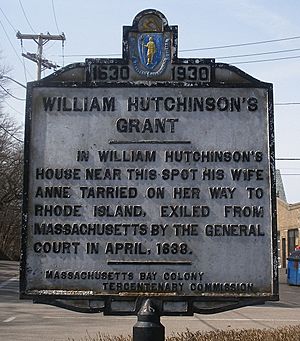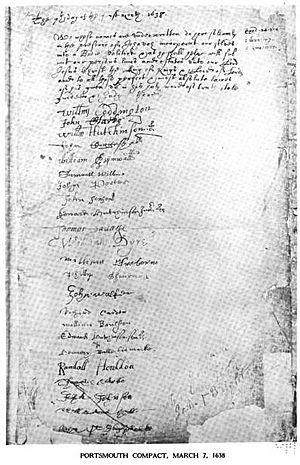William Hutchinson (Rhode Island judge) facts for kids
Quick facts for kids
William Hutchinson
|
|
|---|---|
| 2nd Judge (governor) of the Town of Portsmouth | |
| In office 1639–1640 |
|
| Preceded by | William Coddington |
| Succeeded by | William Coddington as Governor of Newport and Portsmouth |
| Personal details | |
| Born | baptised 14 August 1586 Alford, Lincolnshire, England |
| Died | 1641 Portsmouth, Colony of Rhode Island (Aquidneck Island) |
| Spouse | Anne Hutchinson |
| Children | Edward, Susanna, Richard, Faith, Bridget, Francis, Elizabeth, William, Samuel, Anne, Mary, Katherine, William, Susanna, Zuriel |
| Occupation | Merchant, deputy, magistrate, selectman, treasurer, judge (governor) |
William Hutchinson (1586–1641) was an important leader in the early American colonies. He served as a judge, which was like being a governor, in the town of Portsmouth. This town was on an island called Aquidneck, which was then known as Rhode Island. Later, this area became part of the Colony of Rhode Island and Providence Plantations.
William Hutchinson and his large family sailed from England to New England in 1634. He became a successful merchant in Boston. He also held public offices, serving as a Deputy in the General Court and a selectman. His wife was Anne Hutchinson, who became famous for her religious ideas. These ideas caused a big disagreement with the Puritan leaders of the Massachusetts Bay Colony. Because of this, Anne was forced to leave the colony in 1638.
The Hutchinsons and 18 other people decided to leave and start a new settlement. They founded a town called Pocasset on the Narragansett Bay. This town was later renamed Portsmouth and became one of the first towns in the Rhode Island colony.
In Portsmouth, William Hutchinson became the treasurer. William Coddington was the first judge (or governor). But a disagreement led Coddington to move away in 1639 and start a new town called Newport. After Coddington left, William Hutchinson became the chief leader of Portsmouth. He served as judge for less than a year. He passed away shortly after June 1641. After his death, his wife and many of their younger children moved to New Netherland, an area that is now part of New York City. Sadly, Mrs. Hutchinson and most of her children were killed by Native Americans a short time later.
Governor John Winthrop described William Hutchinson as a calm and gentle person. He also said that William was often influenced by his strong and outspoken wife.
Contents
Early Life in England
William Hutchinson was born into a well-known family in Lincolnshire, England. His grandfather, John Hutchinson, was a mayor in the town of Lincoln several times. William's father, Edward, moved to Alford and had 11 children. William was the oldest, baptized on August 14, 1586, in Alford.
William grew up in Alford. He worked as a merchant, trading cloth, and later moved to London. In London, he reconnected with Anne Marbury, whom he had known in Alford. Anne was the daughter of a clergyman named Francis Marbury. William and Anne married on August 9, 1612, in London.
The Hutchinsons had a large family in Alford, with 14 children born there. Sadly, some of them died young, including two from the plague. William and Anne, especially Anne, greatly admired the sermons of Reverend John Cotton. He was a minister at Saint Botolph's Church in the town of Boston, about 21 miles from Alford. They often traveled to Boston to hear him preach.
John Cotton held strong Puritan beliefs. At the time, the Archbishop William Laud was strict about people following the rules of the official Anglican church. Cotton was forced to hide and then had to leave England to avoid being put in prison. Anne Hutchinson was very upset to lose her favorite preacher. The family planned to sail with him to New England in 1633. However, Anne was pregnant with her 14th child, so they couldn't go. Instead, they sent their oldest son, Edward, who was 20, with Cotton. William's younger brother, also named Edward, was on the same ship.
In 1634, William Hutchinson, Anne, and their ten other children sailed to New England on the ship Griffin. This was the same ship that had taken John Cotton and their oldest son a year earlier. The family first settled in Boston. William joined the Boston Church in October 1634, and Anne joined a week later. He became a merchant in Boston and became a "freeman" in 1635. Being a freeman meant he could vote and hold office. He served as a Deputy to the Massachusetts Bay General Court from 1635 to 1636. He was also a selectman, helping to manage town affairs, from 1635 to 1637.
Challenges in Boston

William Hutchinson's wife, Anne, was a very intelligent and strong-willed woman. She was known for helping people who were sick or in need. However, her religious teachings and her open criticism of most of Boston's ministers caused a major conflict. This disagreement grew between the followers of John Cotton and the older Puritan leaders.
In late 1636, Governor John Winthrop wrote that Mrs. Hutchinson was "a woman of ready wit and bold spirit." But he also believed she was spreading dangerous religious ideas. She held private meetings at her home, attracting many people from Boston and other towns, including important citizens. She taught religious views that were very different from what the Puritan church leaders believed. She also openly disliked most of the Puritan ministers, except for John Cotton. Finally, in November 1637, she was put on trial. She was found guilty and banished, or forced to leave, the colony along with some of her supporters.
Starting Fresh in Rhode Island
Before leaving Boston, William Hutchinson and other supporters of his wife signed the Portsmouth Compact on March 7, 1638. This agreement stated their plan to form a new government based on Christian principles, but without favoring one specific church. The group thought about going to New Netherland. But Roger Williams suggested they buy land on the Narragansett Bay from the Narragansett Native Americans.
They bought Aquidneck Island, which was called Rhode Island at the time. There, they formed a settlement called Pocasset, which was renamed Portsmouth in 1639. In June 1638, Hutchinson became the town's treasurer. William Coddington was named the judge, which was the title for the main leader of the settlement.
The next year, a disagreement caused Coddington and a few other leaders to leave Portsmouth. They started a new settlement at the south end of the island called Newport. William Hutchinson then became the judge (governor) of Portsmouth. He served from 1639 until March 12, 1640. On that date, Portsmouth joined with Newport to form the Colony of Rhode Island. Coddington was elected as the governor of this new two-town colony, and Hutchinson became one of his assistants.
Governor Winthrop wrote about the 1639 disagreement in Portsmouth. He said that "the people grew very tumultuous and put out Mr. Coddington and the other three magistrates." They then chose "Mr. William Hutchinson only, a man of very mild temper and weak parts, and wholly guided by his wife." Winthrop believed Anne Hutchinson had caused all the previous troubles and continued to create problems.
William Hutchinson passed away in Portsmouth shortly after June 1641. After his death, his wife Anne left Rhode Island. She moved to New Netherland, near what is now the border between the Bronx and Westchester County, New York. Sadly, soon after this move, Anne and her entire household were attacked and killed by Native Americans in a conflict during the late summer of 1643. Only one of her daughters survived.
His Family and Legacy
William and Anne Hutchinson had 15 children. All but their last child were born in England. Their oldest child, Edward, became a captain. He later died from injuries he received during a battle called Wheeler's Surprise in King Philip's War.
Their fourth child, Faith, married Thomas Savage, a soldier and merchant from Boston. Their fifth child, Bridget, married John Sanford. John Sanford later became Governor of the two towns on Rhode Island (Portsmouth and Newport) after William Coddington's leadership ended.
Their 14th child, Susanna, was the only one to survive the attack that killed her mother and six of her siblings. She was captured by the Native Americans and held by them for several years.
William Hutchinson's sister, Mary, was married to Reverend John Wheelwright. He was another minister who was banished from Massachusetts and went on to found Exeter, New Hampshire.
Many famous people are descendants of William and Anne Hutchinson. These include U.S. Presidents Franklin D. Roosevelt, George H. W. Bush, and George W. Bush.



